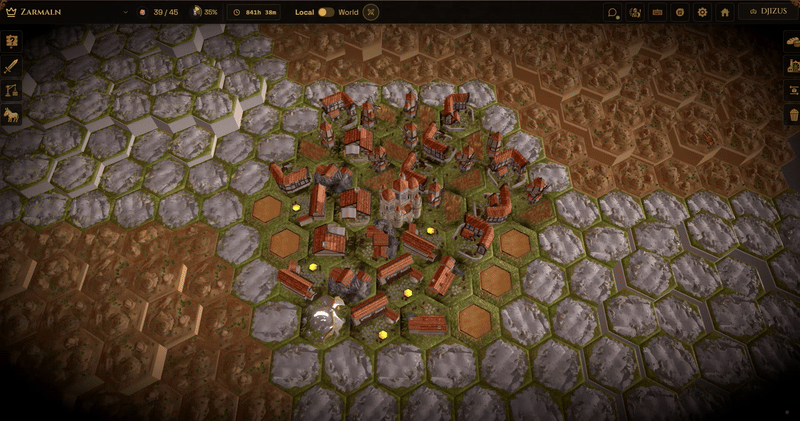🤖 Production Automation
Resource automation allows players to set up continuous production processes within their entities. This system helps manage resource generation and distribution efficiently without constant manual intervention.
Overview
Instead of micromanaging multiple production orders, the automation now runs off a single set of sliders per entity, recomputing the entire plan from those percentages every loop.
Key Features:- Every minute: the client starts up production plans for any owned entity with a valid setup.
- Per-resource percentages: Each tracked resource has sliders for complex and simple recipes.
- Presets: “Labor”, “Resource”, “Custom”, and “Idle” presets instantly distribute percentages across every resource with active buildings, respecting entity type and recipe availability.
- Safety rails: Inputs are capped at 90% of the live balance.
- Local persistence: Configurations are saved per game in your browser so refreshes keep the latest sliders and last-run summaries.
How It Works
Production automation runs a global loop that goes through every owned realm and camp.
- Realm discovery: On execution, the client fetches every owned entity and ensures it has an automation profile.
- Resource scan: Any resource with buildings or an active recipe is auto-added to bootstrap production, even if you never touch the sliders.
- Budgeting: Each resource receives 90% of its current balance as a budget. Sliders dictate how much of that budget the loop can spend on complex vs. simple recipes.
- Plan generation: Recipes reserve inputs according to your percentages and their per-cycle requirements. Recipes without enough inputs are skipped and reported in the summary.
- Execution: If at least one recipe has non-zero cycles, the automation is submitted for that entity.
- Feedback loop: The store records cycles, inputs, outputs, and skipped resources so the UI can show fresh "last run" stats.
Entity Coverage
- Realms and Camps are supported; other entity types are ignored for production automation.
- Losing ownership of a realm automatically prunes the associated automation profile.
Production Types
There are still two production paths, now governed by slider percentages:
- Complex (Resource → Resource):
- Burns existing resources to craft another according to the
Resource → Resourceslider. - Example: Spend Wood + Coal to produce Copper.
- Burns existing resources to craft another according to the
- Simple (Labor → Resource):
- Spends Labor to produce a resource using the
Labor → Resourceslider. - Example: Spending Labor to produce Stone.
- Spends Labor to produce a resource using the
Allocation & Execution Rules
- Percentages replace orders: Every loop recomputes usage based on sliders, entity type, and building activity.
- Per-resource budgets: Complex and labor sliders consume independent portions of the 90% resource budget; zeroing a slider skips that recipe.
- 5% increments & clamping: Sliders move in 5% increments and stay within the 0–90% range.
- Auto-managed lists: Any resource with active production is auto-added so presets work the moment new buildings are created. Removing the building later prunes the entry automatically.
Presets
Labor:Spreads up to 10% labor burn across eligible outputs while respecting shared inputs.Resource:Pushes complex crafting to the ceiling.Custom:Combines resource + labor preset.Idle:Drops every slider to 0%, effectively pausing production for that entity.
Managing Automation Orders (UI)

- Open a realm or camp and select the Automation panel in the right side navigation menu.
- Click modify to open up the production setup.
- Adjust percentages:
Resource → Resource: How much of that resource’s complex inputs to burn per loop.Labor → Resource: How much labor-based production to run (disabled for Donkeys and military-only recipes).
- Apply presets (optional): Labor, Resource, Custom, and Idle presets instantly redistribute sliders across the entity.
- Repeat for other entities. Changes save instantly and feed into the next global loop.
Auto-balancing & Maintenance
- When new buildings finish, their resources auto-insert into the automation list so presets continue to work.
- Resetting an entity wipes its allocations but keeps the entity record for fast reconfiguration.
- At the start of a new Blitz season, stored configs are cleared to avoid stale setups.
Pausing Automation
You can pause production at different levels:
- Individual Resource: Set both sliders to 0% for a single resource.
- Entity-wide: Apply the Idle preset to drop all sliders to 0% until you are ready to resume.
Execution Summaries
After each loop the realm panel shows:
- Timestamp of the last run.
- Produced/Consumed totals grouped by resource so you can see net flows.
- Skipped recipes plus reasons (missing inputs, missing labor recipe, etc.).
- Total cycles executed across complex and simple recipes.
Use this view to verify slider settings or debug why a resource isn’t running (e.g., depleted labor inputs).
Important Considerations
General Requirements
- Browser must stay open: The automation store lives in your browser. Closing the Blitz tab pauses every loop.
- Loop cadence: Production automation evaluates roughly every 60 seconds; it won’t react faster even if you change a slider immediately.
Production Automation Considerations
- Resource availability: Production only executes if the realm has the required inputs at processing time.
- Recipe dependencies: You can’t produce outputs that lack valid recipes or buildings.
Best Practices
- Start conservative: Begin with low percentages to watch how inputs drain.
- Monitor early loops: Use execution summaries after the first few runs to confirm cycle counts and skips.
- Lean on presets: Labor/Resource/Idle presets are the fastest way to reorient an entity without endless slider drags.
